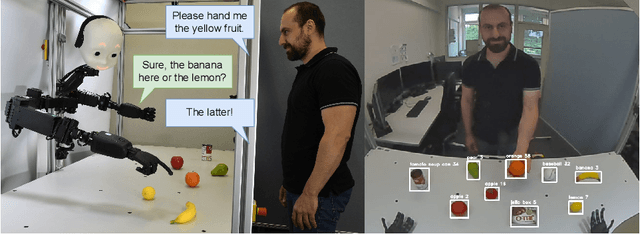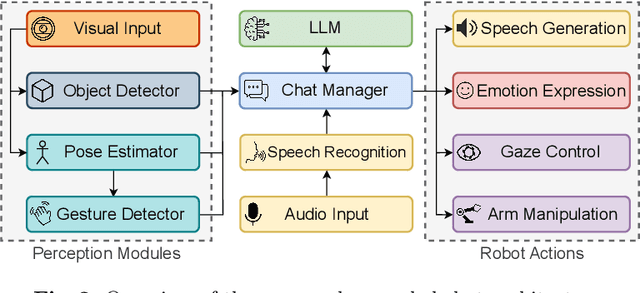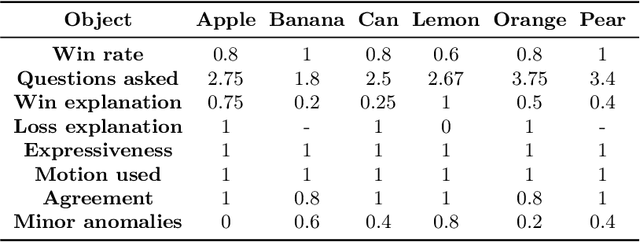Stefan Wermter
University of Hamburg
Balancing long- and short-term dynamics for the modeling of saliency in videos
Apr 08, 2025Abstract:The role of long- and short-term dynamics towards salient object detection in videos is under-researched. We present a Transformer-based approach to learn a joint representation of video frames and past saliency information. Our model embeds long- and short-term information to detect dynamically shifting saliency in video. We provide our model with a stream of video frames and past saliency maps, which acts as a prior for the next prediction, and extract spatiotemporal tokens from both modalities. The decomposition of the frame sequence into tokens lets the model incorporate short-term information from within the token, while being able to make long-term connections between tokens throughout the sequence. The core of the system consists of a dual-stream Transformer architecture to process the extracted sequences independently before fusing the two modalities. Additionally, we apply a saliency-based masking scheme to the input frames to learn an embedding that facilitates the recognition of deviations from previous outputs. We observe that the additional prior information aids in the first detection of the salient location. Our findings indicate that the ratio of spatiotemporal long- and short-term features directly impacts the model's performance. While increasing the short-term context is beneficial up to a certain threshold, the model's performance greatly benefits from an expansion of the long-term context.
LLM+MAP: Bimanual Robot Task Planning using Large Language Models and Planning Domain Definition Language
Mar 21, 2025Abstract:Bimanual robotic manipulation provides significant versatility, but also presents an inherent challenge due to the complexity involved in the spatial and temporal coordination between two hands. Existing works predominantly focus on attaining human-level manipulation skills for robotic hands, yet little attention has been paid to task planning on long-horizon timescales. With their outstanding in-context learning and zero-shot generation abilities, Large Language Models (LLMs) have been applied and grounded in diverse robotic embodiments to facilitate task planning. However, LLMs still suffer from errors in long-horizon reasoning and from hallucinations in complex robotic tasks, lacking a guarantee of logical correctness when generating the plan. Previous works, such as LLM+P, extended LLMs with symbolic planners. However, none have been successfully applied to bimanual robots. New challenges inevitably arise in bimanual manipulation, necessitating not only effective task decomposition but also efficient task allocation. To address these challenges, this paper introduces LLM+MAP, a bimanual planning framework that integrates LLM reasoning and multi-agent planning, automating effective and efficient bimanual task planning. We conduct simulated experiments on various long-horizon manipulation tasks of differing complexity. Our method is built using GPT-4o as the backend, and we compare its performance against plans generated directly by LLMs, including GPT-4o, V3 and also recent strong reasoning models o1 and R1. By analyzing metrics such as planning time, success rate, group debits, and planning-step reduction rate, we demonstrate the superior performance of LLM+MAP, while also providing insights into robotic reasoning. Code is available at https://github.com/Kchu/LLM-MAP.
Shaken, Not Stirred: A Novel Dataset for Visual Understanding of Glasses in Human-Robot Bartending Tasks
Mar 06, 2025Abstract:Datasets for object detection often do not account for enough variety of glasses, due to their transparent and reflective properties. Specifically, open-vocabulary object detectors, widely used in embodied robotic agents, fail to distinguish subclasses of glasses. This scientific gap poses an issue to robotic applications that suffer from accumulating errors between detection, planning, and action execution. The paper introduces a novel method for the acquisition of real-world data from RGB-D sensors that minimizes human effort. We propose an auto-labeling pipeline that generates labels for all the acquired frames based on the depth measurements. We provide a novel real-world glass object dataset that was collected on the Neuro-Inspired COLlaborator (NICOL), a humanoid robot platform. The data set consists of 7850 images recorded from five different cameras. We show that our trained baseline model outperforms state-of-the-art open-vocabulary approaches. In addition, we deploy our baseline model in an embodied agent approach to the NICOL platform, on which it achieves a success rate of 81% in a human-robot bartending scenario.
DIRIGENt: End-To-End Robotic Imitation of Human Demonstrations Based on a Diffusion Model
Jan 28, 2025Abstract:There has been substantial progress in humanoid robots, with new skills continuously being taught, ranging from navigation to manipulation. While these abilities may seem impressive, the teaching methods often remain inefficient. To enhance the process of teaching robots, we propose leveraging a mechanism effectively used by humans: teaching by demonstrating. In this paper, we introduce DIRIGENt (DIrect Robotic Imitation GENeration model), a novel end-to-end diffusion approach that directly generates joint values from observing human demonstrations, enabling a robot to imitate these actions without any existing mapping between it and humans. We create a dataset in which humans imitate a robot and then use this collected data to train a diffusion model that enables a robot to imitate humans. The following three aspects are the core of our contribution. First is our novel dataset with natural pairs between human and robot poses, allowing our approach to imitate humans accurately despite the gap between their anatomies. Second, the diffusion input to our model alleviates the challenge of redundant joint configurations, limiting the search space. And finally, our end-to-end architecture from perception to action leads to an improved learning capability. Through our experimental analysis, we show that combining these three aspects allows DIRIGENt to outperform existing state-of-the-art approaches in the field of generating joint values from RGB images.
FabuLight-ASD: Unveiling Speech Activity via Body Language
Nov 20, 2024Abstract:Active speaker detection (ASD) in multimodal environments is crucial for various applications, from video conferencing to human-robot interaction. This paper introduces FabuLight-ASD, an advanced ASD model that integrates facial, audio, and body pose information to enhance detection accuracy and robustness. Our model builds upon the existing Light-ASD framework by incorporating human pose data, represented through skeleton graphs, which minimises computational overhead. Using the Wilder Active Speaker Detection (WASD) dataset, renowned for reliable face and body bounding box annotations, we demonstrate FabuLight-ASD's effectiveness in real-world scenarios. Achieving an overall mean average precision (mAP) of 94.3%, FabuLight-ASD outperforms Light-ASD, which has an overall mAP of 93.7% across various challenging scenarios. The incorporation of body pose information shows a particularly advantageous impact, with notable improvements in mAP observed in scenarios with speech impairment, face occlusion, and human voice background noise. Furthermore, efficiency analysis indicates only a modest increase in parameter count (27.3%) and multiply-accumulate operations (up to 2.4%), underscoring the model's efficiency and feasibility. These findings validate the efficacy of FabuLight-ASD in enhancing ASD performance through the integration of body pose data. FabuLight-ASD's code and model weights are available at https://github.com/knowledgetechnologyuhh/FabuLight-ASD.
A Framework for Adapting Human-Robot Interaction to Diverse User Groups
Oct 15, 2024



Abstract:To facilitate natural and intuitive interactions with diverse user groups in real-world settings, social robots must be capable of addressing the varying requirements and expectations of these groups while adapting their behavior based on user feedback. While previous research often focuses on specific demographics, we present a novel framework for adaptive Human-Robot Interaction (HRI) that tailors interactions to different user groups and enables individual users to modulate interactions through both minor and major interruptions. Our primary contributions include the development of an adaptive, ROS-based HRI framework with an open-source code base. This framework supports natural interactions through advanced speech recognition and voice activity detection, and leverages a large language model (LLM) as a dialogue bridge. We validate the efficiency of our framework through module tests and system trials, demonstrating its high accuracy in age recognition and its robustness to repeated user inputs and plan changes.
QT-TDM: Planning with Transformer Dynamics Model and Autoregressive Q-Learning
Jul 26, 2024Abstract:Inspired by the success of the Transformer architecture in natural language processing and computer vision, we investigate the use of Transformers in Reinforcement Learning (RL), specifically in modeling the environment's dynamics using Transformer Dynamics Models (TDMs). We evaluate the capabilities of TDMs for continuous control in real-time planning scenarios with Model Predictive Control (MPC). While Transformers excel in long-horizon prediction, their tokenization mechanism and autoregressive nature lead to costly planning over long horizons, especially as the environment's dimensionality increases. To alleviate this issue, we use a TDM for short-term planning, and learn an autoregressive discrete Q-function using a separate Q-Transformer (QT) model to estimate a long-term return beyond the short-horizon planning. Our proposed method, QT-TDM, integrates the robust predictive capabilities of Transformers as dynamics models with the efficacy of a model-free Q-Transformer to mitigate the computational burden associated with real-time planning. Experiments in diverse state-based continuous control tasks show that QT-TDM is superior in performance and sample efficiency compared to existing Transformer-based RL models while achieving fast and computationally efficient inference.
Robots Can Multitask Too: Integrating a Memory Architecture and LLMs for Enhanced Cross-Task Robot Action Generation
Jul 18, 2024Abstract:Large Language Models (LLMs) have been recently used in robot applications for grounding LLM common-sense reasoning with the robot's perception and physical abilities. In humanoid robots, memory also plays a critical role in fostering real-world embodiment and facilitating long-term interactive capabilities, especially in multi-task setups where the robot must remember previous task states, environment states, and executed actions. In this paper, we address incorporating memory processes with LLMs for generating cross-task robot actions, while the robot effectively switches between tasks. Our proposed dual-layered architecture features two LLMs, utilizing their complementary skills of reasoning and following instructions, combined with a memory model inspired by human cognition. Our results show a significant improvement in performance over a baseline of five robotic tasks, demonstrating the potential of integrating memory with LLMs for combining the robot's action and perception for adaptive task execution.
Unconstrained Open Vocabulary Image Classification: Zero-Shot Transfer from Text to Image via CLIP Inversion
Jul 15, 2024Abstract:We introduce NOVIC, an innovative uNconstrained Open Vocabulary Image Classifier that uses an autoregressive transformer to generatively output classification labels as language. Leveraging the extensive knowledge of CLIP models, NOVIC harnesses the embedding space to enable zero-shot transfer from pure text to images. Traditional CLIP models, despite their ability for open vocabulary classification, require an exhaustive prompt of potential class labels, restricting their application to images of known content or context. To address this, we propose an "object decoder" model that is trained on a large-scale 92M-target dataset of templated object noun sets and LLM-generated captions to always output the object noun in question. This effectively inverts the CLIP text encoder and allows textual object labels to be generated directly from image-derived embedding vectors, without requiring any a priori knowledge of the potential content of an image. The trained decoders are tested on a mix of manually and web-curated datasets, as well as standard image classification benchmarks, and achieve fine-grained prompt-free prediction scores of up to 87.5%, a strong result considering the model must work for any conceivable image and without any contextual clues.
When Robots Get Chatty: Grounding Multimodal Human-Robot Conversation and Collaboration
Jun 29, 2024



Abstract:We investigate the use of Large Language Models (LLMs) to equip neural robotic agents with human-like social and cognitive competencies, for the purpose of open-ended human-robot conversation and collaboration. We introduce a modular and extensible methodology for grounding an LLM with the sensory perceptions and capabilities of a physical robot, and integrate multiple deep learning models throughout the architecture in a form of system integration. The integrated models encompass various functions such as speech recognition, speech generation, open-vocabulary object detection, human pose estimation, and gesture detection, with the LLM serving as the central text-based coordinating unit. The qualitative and quantitative results demonstrate the huge potential of LLMs in providing emergent cognition and interactive language-oriented control of robots in a natural and social manner.
 Add to Chrome
Add to Chrome Add to Firefox
Add to Firefox Add to Edge
Add to Edge